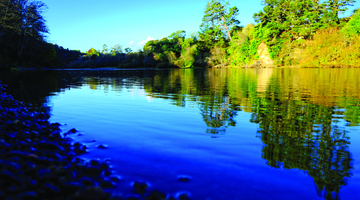Taroi Rawiri is a fisheries officer and was raised in Waikato, so he is very familiar with it and the issues around it. Taroi would like to see the river become and remain a sustainable resource through proper management. Taroi inherited much of his knowledge of mātauranga from his grandmother Iti Rangihinemutu Rawiri.
Transcript
TAROI RAWIRI
Me and the wife Erina we had talked about doing a tira hou for the whānau, so it was my mum and dad, my brothers and my sisters, and we did that. We paddled from Karāpiro. We started on the… it was in between Christmas and New Year’s during that Christmas break, and then 3 days, we went from Karāpiro, stopped in Huntly on the first day, from Huntly to Tuakau Bridge and then from Tuakau Bridge out to the coast. Yeah, we made it – it was a bit of slog, but it was good. We had some of the whānau jump in, which was awesome.
That was sort of part of the thing I was trying to get is from the old man to talk to our young ones about his life on the river and what sort of things they got up to as kids and his whole upbringing about it. So he shared that. My wife Erina – her mahi that she does in science, freshwater science – about what she’s done on the river and just my work as a fisheries officer. Yeah, just get the kids to see different things.
Having spent that time with my nan and that and with my parents, it’s not just another place that I’m working. You can take some ownership there and making sure that things are right and no one’s going to do anything to it that’s going to affect the future generations – and that’s, for me, that’s pretty cool. You know, you’ve got the commercial industry, making sure that they follow all their stuff and hopefully it will be a sustainable fishery in our awa.
That message of once it’s gone there’s really nothing we can do about it, it’s an awesome resource at the moment and getting there. It’s all about getting that buy-in you know, it’s not about stopping you taking what you want, taking your kai, you can still do that. If you need more, there’s avenues for that like for instance kaitiaki – using that.
The whole big thing about kaitiaki, it’s not about issuing them the right to go get a kai, it’s about managing the area by knowing what’s there, what’s going out, and you know if one area is getting hard to take from, they can rest that place, send them somewhere else so that would rebuild. And that’s that whole, I guess, the mana in that role about them taking, that’s their responsibility for that area.
And the best way to help them is by going to see them, talk to them, get your permits, and then they’ll know where the kai’s good, where the kai’s a little bit scarce, and then once you get that sort of buy-in from that, hopefully, they’re keen to help.
Acknowledgements:
Taroi Rawiri
The Waikato Tainui College for Research and Development acknowledges the financial support given by the Waikato River Cleanup Trust Fund which is administered by the Waikato River Authority.
The Waikato River Cleanup Trust does not necessarily endorse or support the content of the publication in any way.


